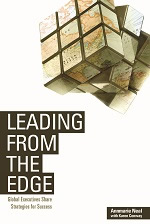ATD Blog
Think Organization When Developing Leadership
Tue Apr 30 2013
Recently, I had the opportunity to facilitate an executive development program in which business leaders were discussing the need to bring innovation and business transformation to their organizations.

Never before has the world of business been more complex, more turbulent and more evolutionary. Starwood Resorts CEO, Frits van Paasschen refers to these times as the age of great change – a time of which geopolitical, economic, global, social and technology trends converge with such speed that the pace of change accelerates exponentially resulting in global shifts in capital, in power and in how, where and with whom business is conducted.
If the strategy and economic models of the past are no longer relevant, what makes us think the organizational, leadership or talent models are?
As we apply traditional mindsets and models of leadership, it becomes clear pretty quickly that we would need the ‘bionic man’ leading our organizations – someone with extraordinary capabilities to out run, out jump and out maneuver the opponent. Honestly, few have these skills, capabilities and experience. And fewer can develop them in the timeframe that most of our businesses need them.
So rather than looking toward leadership development to close our leadership gaps, I wonder if we could start thinking more innovatively about leadership – and more importantly the role of the organization as we move into the future?
Today, our organizations rely heavily on a few to set the course for value creation. What if we leveraged more dynamic organizational models to drive value creation? I am not talking about moving from hierarchical to matrix models. I am talking much more creatively. Think Red Hat and Pixar!
Red Hat leverages open source models not only to develop software but also to build business strategy and organizational culture. Red Hat’s CEO, Jim Whitehurst leverages strong operational models to drive productivity at Red Hat. But he creatively leverages the company’s go to market strategy to engage his partner, customer and employee ecosystems to bring differentiated value to its customers and as importantly to his employees. And, Pixar creatively and effectively leverages open markets for talent to assemble and leverage mission critical capabilities to produce movies and bring them to market. Such innovative organization models leverage many forms of leadership, and just-in-time.
As we innovate our organization models – we also need to innovate our leadership models. My perspective is that we often focus too much on what leaders have done and can do, rather than who leaders are at their core. In this age of great change leaders need to operate with greater world purpose, with greater attention to that which it takes to innovate in the core and at the edge, with greater attention to the ecosystems and value chains in which they create and extract value and with greater transparency in how they engage their employees and stakeholders.
Our role as HR and Talent professionals must transform as well. It is no longer good enough for us to bring programs and tools to our organization’s leaders. We must bring innovative solutions in how we organize, align, collaborate, innovate and transform how we do business. Our ability to impact the future of organizations and create the value that the business expects us to create will come from our ability to push away from tradition in pursuit of developing the future.
I encourage you to ‘think with me’ on this topic. How do we push past tradition to bring innovative practices to our businesses?
You've Reached ATD Member-only Content
Become an ATD member to continue
Already a member?Sign In
